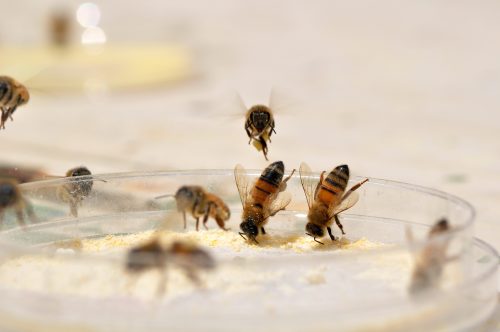Researchers from the Hebrew University discovered how the honey bee prefers a balanced diet and supplements nutritional deficiencies that threaten its existence

It is known that for humans a balanced menu and proper nutrition are essential for managing a healthy lifestyle and preventing disease. It turns out that honey bees knew the secrets of a balanced diet even before us.
The bee is attracted to plants and flowers to find food there - nectar and flower pollen (pollen). As she consumes her food and collects the pollen to bring to the hive, the pollen grains stick to her hairy body and thus she carries pollen from flower to flower. The diversity in the food of the little flying bird is extremely essential for the development of its resilience and function in areas with little food or in drought-stricken areas.
Colonies of honey bees growing in agricultural areas for crop pollination face nutritional deficiencies, when food collection relies on a single source of pollen, such as an orchard of fruit trees of one variety. Poor nutrition may affect the immune system of the bees, their health and their life expectancy.
In a new study published in the journal Behavioral Ecology and Sociobiology (Link) discovered by Prof. Sharoni Shapir and Dr. Herman Hendricksma from the Benjamin Trioux Center for Bee Research at the Robert H. Faculty of Agriculture, Food and Environment. Smith at the Hebrew University, because honey bees naturally choose to be attracted to plants and flowers that have pollen that contains the nutrients missing in the colonies.
"Our research reveals the amazing ability of the bees to locate and prefer among the pollination sources accessible to them those that will supplement the nutritional deficiencies in their colonies. The honey bee makes the balanced choice freely and naturally, and this ability maintains its strong resistance in situations of nutritional deficiency," says Prof. Sharoni.
In the experiment they conducted, the researchers placed eight bee colonies in closed enclosures within which they were provided with pollen substitutes lacking in essential amino acids. After that, the researchers examined the free choice made by the bees between different pollen substitutes: substitutes with the same nutritional balance as the one given to them in the closed enclosure; Substitutes with a nutritional balance that was deficient in a similar way to the substitutes given to them in the closed enclosure; and substitutes with nutrition that made up for the deficiencies from the food provided to them in the closed compound.
A video showing the experimental phase in which the honeybees choose pollen substitutes after being fed a substitute with a deficiency of amino acids. Photo: Herman Hendricksma
"The honey bees preferred the supplementary diet over the other options. Not only did they tend to choose flowers that were more diverse in their nutritional composition, they also preferred the certain plants that supplemented the certain deficiencies that were in the diet that was intended for the colonies earlier. In this way, the bees remind us that in nutrition, as in many other things, balance is the key word," explained Dr. Hendricksma.
A video showing the honeybees' choice of a pollen substitute that supplements the missing nutrients in the diet they were given. Photo: Herman Hendricksma
Honey bees are the main pollinators in the agricultural sector - one third of the amount of fresh agricultural food in the world is produced with the help of the honey bee's flight from flower to flower, and it is also responsible for about three quarters of the variety of existing agricultural crops.
Since the ecosystem is made possible thanks to the bees and their pollination activity, the problem of the disappearance of the bees in the world has accelerated many bodies to act to preserve their food sources in pastures, orchards and green lungs, to plant trees and shrubs and increase crypto food sources for the bees.
Even at the individual level, it is possible to expand and diversify the bee's food sources by planting flowers of any variety and anywhere.
